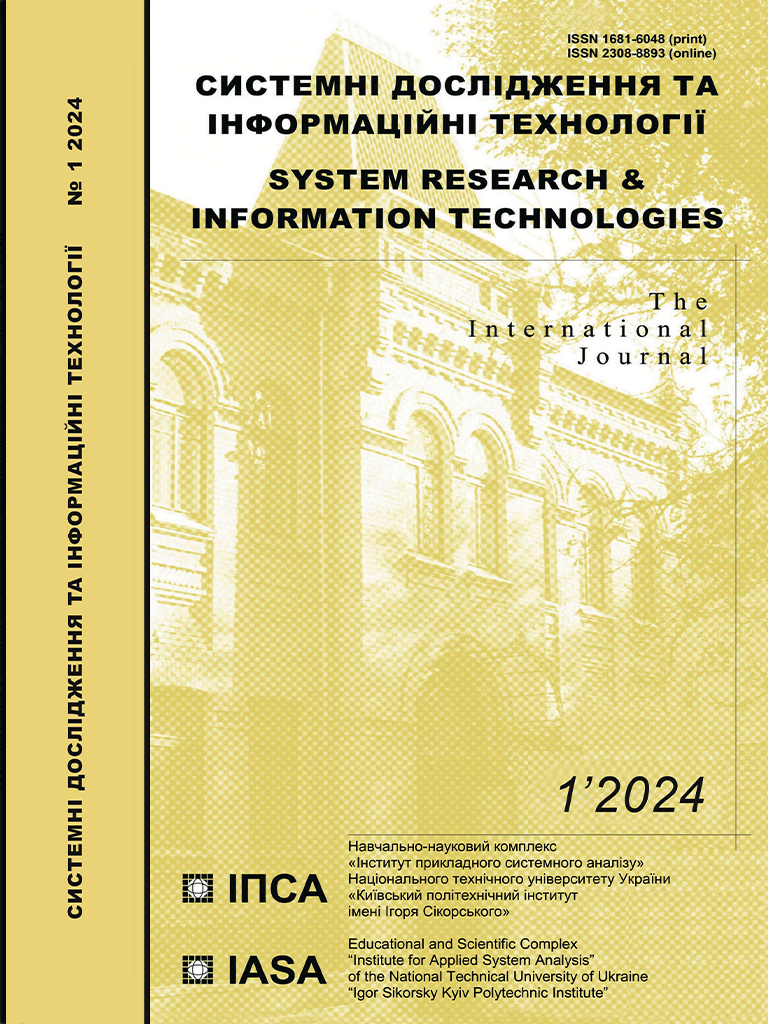Study on the profitability of agricultural enterprises in Ukraine during the russian military invasion of Ukraine
DOI:
https://doi.org/10.20535/SRIT.2308-8893.2024.1.05Keywords:
economic and mathematical models, heteroscedasticity, models of regression analysis, profitability, income, linear regression, nonlinear model, full-scale russian invasion of UkraineAbstract
This paper examines the effectiveness of grouping agricultural enterprises according to the wheat harvested area and assesses their profitability. We have developed linear and non-linear regression equations to predict the income for said groups of enterprises. The methodology is designed for cases when future market prices are probabilistic in nature. With the help of the developed methodology, it is possible to calculate the necessary production volumes in the conditions of price fluctuations. We have used the Goldfeld–Quandt parametric test to test the model for heteroscedasticity. Calculations show that agricultural holdings are indeed inefficient, and preference should be given to enterprises with medium crop areas. Application of the Lagrange multipliers method when solving the problem of agricultural enterprise optimization makes it possible to increase profitability. The case of price risk, when future market prices are not deterministic, is considered. Therefore, it is necessary to be guided by two criteria when making managerial decisions: to maximize the expected total net income and to minimize the variance of the total net income.
References
M. Shahbandeh, “Global leading wheat producing countries 2022/2023,” Statista. 2023, March 10. Available: https://www.statista.com/statistics/237912/global-top-wheat-producing-countries/
Ministry of Agrarian Policy and Food of Ukraine. [Official website]. 2022. Available: https://minagro.gov.ua/en
FAOSTAT (2022). Statistical database of food and agriculture organization of the United Nations. [Online]. Accessed on: March 15, 2022. Available: http://faostat.fao.org/faostat/
Statistical Yearbook of Ukraine, 2021. State Statistics Service of Ukraine. [Online]. Accessed on: February 2, 2022. Available: http://www.ukrstat.gov.ua
Socio-economic characteristics of households in Ukraine 2021. State Statistics Service of Ukraine. [Online]. Accessed on: February 2, 2022. Available: http://www.ukrstat.gov.ua
C. Lee, G. Schluter, and B. O’Roark, “How Much Would Increasing the Minimum Wage Affect Food Prices?” Agriculture Information Bulletin, vol. 3, p. 747, 2000. doi: 10.22004/ag.econ.33598.
J. Sánchez-Fung, “Institutions for macroeconomic stability: a review of Monetary policy in low financial development countries,” Macroeconomics and Finance in Emerging Market Economies, vol. 15(1), 2022. Available: https://doi.org/10.1080/17520843.2022.2096913
I.S. Danilova and O.M. Hetmanets, “Method of determining the degree of freshness of snail meat by the photometric method (Patent of Ukraine No. 128984),” Ministry of Economic Development and Trade of Ukraine. 2018. Retrieved from https://sis.ukrpatent.org/uk/search/detail/237538/
V.V. Kasianchuk and N.M. Bohatko, “Method for determining degree of freshness of beef and pork meat (Patent of Ukraine No. 59032),” Ministry of Education and Science of Ukraine. 2003. Retrieved from https://uapatents.com/3-59032-sposib-viznachennya-stupenya-svizhosti-yalovichini-ta-svinini.html
H. Taha, Operations Research: An Introduction Pearson; 10th edition, 2016, 848 p.
H. Rasool and Md. Tarique, “Testing the link between Rural Wages and Food Inflation in India A Co-integration Approach,” IOSR 2 (IOSR-JBM), vol. 20(1), pp. 87–98, 2018. doi: 10.9790/487X-2001018798.
A. Dorward, “The short- and medium-term impacts of rises in staple food prices,” Food Security, vol. 4, pp. 633–645, 2012. Available: https://doi.org/10.1007/s12571-012-0210-3
P. Sitikantha, M. Silu, and R. Soumyajit, “Inflation expectations of households: do they influence wage-price dynamics in India?” Macroeconomics and Finance in Emerging Market Economies, vol. 13(3), pp. 244–263, 2020. Available: https://doi.org/10.1080/17520843.2020.1720264
D.I. Babmindra, Obtaining positive financial benefits as a way to get the agro-industrial complex out of the crisis. Available: http://nbuv.gov.ua/UJRN/Zik_2013_2_6
P. Biber, T. Duckett, “Dynamic maps for long-term operation of mobile service robots,” Robotics: Science and Systems I, June 8–11, pp. 17–24, 2005. Available: http://dx.doi.org/10.15607/RSS.2005.I.003
R. Bhattacharya, A.Sen Gupt, “Drivers and impact of food inflation in India,” Macroeconomics and Finance in Emerging Market Economies, vol. 11(2), pp. 146–168, 2018. Available: https://doi.org/10.1080/17520843.2017.1351461
E. Nwaolisa, “Effects of Exchange Rate Fluctuations on the Balance of Payment in the Nigerian Economy. Approach,” IOSR Journal of Business and Management (IOSR-JBM), vol. 5(12), p. 7576–7583, 2017. Available: https://doi.org/10.18535/ijsrm/v5i12.01
United Nations Organization. Available: http: //www.un.org/en/index.html
I. Wilson, “Strategic planning for the millennium: Resolving the dilemma,” Long rouge planning, vol. 31, no. 4, pp. 507–551, Oxford etc., 2017. doi: 10.4236/ajibm.2017.74035.
A. Silva, A. Carrara, and N. Castro, “Inflation persistence for product groups in Brazil using the ARFIMA-GARCH model,” Macroeconomics and Finance in Emerging Market Economies, vol. 15, issue 3, 2022. Available: https://doi.org/10.1080/17520843.2022.2080345
Finbalance. Available: https://finbalance.com.ua/news/nbu-serednorichna-inflyatsiya-v-2023-rotsi-bude-203
M. Usman, M.U. Rezekina, A. Baihaqi, and Srihandayani, “Analysis of export competitiveness of natural rubber from Indonesia and Thailand in the international market,” Scientific Journal of Accountancy, Management and Finance, 1(4), pp. 220–230. doi: 10.33258/economit.v1i4.588.
I. Yuliadi, “A survey of agglomeration determinants in Indonesia,” Academic Journal of Interdisciplinary Studies, 10(1), pp. 304–312, 2021. doi: 10.36941/ajis-2021-0026.
M. Dyadkova and G. Momchilov, Constant market shares analysis beyond the intensive margin of external trade. Bulgaria: Bulgarian National Bank, 2014.
E. Efendi et al., “Implementation of greedy algorithm for profit and cost analysis of swallow’s nest processing dirty to finished products,” INFOKUM, 10(02), pp. 849–858, 2022.

